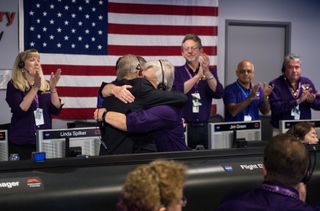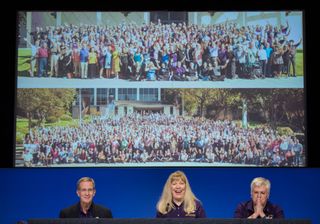Tears and Applause: Cassini Team Reflects on Saturn Plunge
After the Cassini spacecraft's final dive into Saturn's atmosphere, the mission's scientists and engineers say they're proud of the little spacecraft that went far beyond expectations, sad to lose their constant view of Saturn and family of researchers, eager to return to that planet and its mesmerizing moons — and ready for some champagne.
Key members of the Cassini team gathered at NASA's Jet Propulsion Laboratory (JPL) in California today (Sept. 15) to address the media just after watching their spacecraft make its final plunge, gathering first-of-its-kind data about the ringed planet's atmosphere on the way down.
"When I look back over the Cassini mission, I see a mission that was running a 13-year marathon of scientific discovery, and this last orbit was just the last lap — and so we stood in celebration of successfully completing the race," Linda Spilker, the Cassini project scientist at JPL, said during the news conference. "I know I stood there with a mixture of applause and tears. Because it felt so much like losing a friend, a spacecraft I had gotten to know so well. [In Photos: Cassini Mission Ends with Epic Dive into Saturn]

"And yet in looking ahead, both an end and a beginning, there's so much left," she added. "So much incredible science left to figure out and understand — decades' worth — science that will span a generation."
The panelists dwelled on the spacecraft's extraordinary journey, which they said it executed flawlessly and beyond all expectations.
"I almost have no words," Julie Webster, the Cassini spacecraft operations manager at JPL, said at the news conference. "We've had 13 years at Saturn but 20 years of an incredible spacecraft that was designed by people — and I can't emphasize this enough — that had 30 years of experience when they designed it. They took all the lessons learned from the Voyagers, and the Galileos, and the Magellans, and Mars Observer, and built a perfect spacecraft. Right to the last end."

Webster wasn't nervous during the final dive — Cassini's first unprecedented plunge between Saturn and its rings in April was far more nerve-wracking. "I could barely speak, I could barely breathe, when we were waiting for that signal, to say that we got through, inside the rings," she said. "And this last time, I have no words, because it did exactly what it said it was supposed to do. Even better. As it always did." [How Cassini's Saturn Mission Worked (Infographic)]
Get the Space.com Newsletter
Breaking space news, the latest updates on rocket launches, skywatching events and more!
Earl Maize, the Cassini program manager at JPL, said he had "a whole potpourri" of feelings — particularly that it was an extension of the researchers' senses at Saturn, and now that connection is gone.
As for the Cassini spacecraft itself: "I can talk about it being a robot that finished the end of its serviceable life and needs to be put in the junk pile, and there's an element of truth to that," he said. "There's also an element of truth that it's been our companion, and our dutiful servant for several decades. It is a loss, but there's also a sense of serenity and peace with that, because we've done exactly what we believe is the correct thing."
"Cassini has revealed a Saturn as familiar as our own neighborhood might be," Spilker added. "And now, for a time, until we go back, that's a very distant world — just a small, little world in a telescope. And those details of the rings, those tiny moons snuggled in so close — those are all gone. Until we go back."
Thomas Zurbuchen, associate administrator of the science mission directorate at NASA headquarters, was focused on getting back to explore those extraordinary moons as well — particularly Enceladus, among the most likely candidates in the solar system to potentially host or develop life, as well as Saturn's intriguing largest moon, Titan. [Habitable Titan? Cassini, Huygens Revealed Wonders of Saturn's Biggest Moon]
"With today's end of this mission, we now know the planet's moon will remain pristine," Zurbuchen said at the conference. "Not only did we do science here at the very end, but we protected science to be done in the future, and we can — and will, I'm sure, over time — find ways to go back to these moons and explore them, because the questions they have made us ask keep us up at night."
But in the meantime, the spacecraft's final, priceless data from the plunge, as well as that gathered from its 22 daring dives between the planet and its rings, are still waiting for analysis, hiding the final discoveries from that spacecraft. As Michael Watkins, the director of JPL, put it at the conference, "Those last few seconds might be a number of Ph.D. theses for students to come."
Cassini's science team will have a lot of work ahead, but they'll be spending time this afternoon to reminisce about the mission, Spilker said. The flight team, on the other hand, is going to sleep, and will get together Sunday afternoon — "but I don't think we're going to wait until then to open the champagne," Maize added.
"The Cassini mission ended this morning, high over the clouds of Saturn," Maize said in summary. "The spacecraft is gone. Thanks and farewell, faithful explorer. But the legacy of Cassini has just begun — the effect that Cassini has, and will have, on the future of planetary exploration will go on for decades. Long live Cassini."
"Don't ask me tomorrow if I'm ready to build another one," Webster said. "But you can ask me next month."
Email Sarah Lewin at slewin@space.com or follow her @SarahExplains. Follow us @Spacedotcom, Facebook and Google+. Original article on Space.com.
Join our Space Forums to keep talking space on the latest missions, night sky and more! And if you have a news tip, correction or comment, let us know at: community@space.com.

Sarah Lewin started writing for Space.com in June of 2015 as a Staff Writer and became Associate Editor in 2019 . Her work has been featured by Scientific American, IEEE Spectrum, Quanta Magazine, Wired, The Scientist, Science Friday and WGBH's Inside NOVA. Sarah has an MA from NYU's Science, Health and Environmental Reporting Program and an AB in mathematics from Brown University. When not writing, reading or thinking about space, Sarah enjoys musical theatre and mathematical papercraft. She is currently Assistant News Editor at Scientific American. You can follow her on Twitter @SarahExplains.
